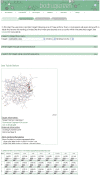BioDrugScreen: a computational drug design resource for ranking molecules docked to the human proteome
- PMID: 19923229
- PMCID: PMC2808957
- DOI: 10.1093/nar/gkp852
BioDrugScreen: a computational drug design resource for ranking molecules docked to the human proteome
Abstract
BioDrugScreen is a resource for ranking molecules docked against a large number of targets in the human proteome. Nearly 1600 molecules from the freely available NCI diversity set were docked onto 1926 cavities identified on 1589 human targets resulting in >3 million receptor-ligand complexes requiring >200,000 cpu-hours on the TeraGrid. The targets in BioDrugScreen originated from Human Cancer Protein Interaction Network, which we have updated, as well as the Human Druggable Proteome, which we have created for the purpose of this effort. This makes the BioDrugScreen resource highly valuable in drug discovery. The receptor-ligand complexes within the database can be ranked using standard and well-established scoring functions like AutoDock, DockScore, ChemScore, X-Score, GoldScore, DFIRE and PMF. In addition, we have scored the complexes with more intensive GBSA and PBSA approaches requiring an additional 120,000 cpu-hours on the TeraGrid. We constructed a simple interface to enable users to view top-ranking molecules and access purchasing and other information for further experimental exploration.
Figures




Similar articles
-
KEGG for representation and analysis of molecular networks involving diseases and drugs.Nucleic Acids Res. 2010 Jan;38(Database issue):D355-60. doi: 10.1093/nar/gkp896. Epub 2009 Oct 30. Nucleic Acids Res. 2010. PMID: 19880382 Free PMC article.
-
The Universal Protein Resource (UniProt) in 2010.Nucleic Acids Res. 2010 Jan;38(Database issue):D142-8. doi: 10.1093/nar/gkp846. Epub 2009 Oct 20. Nucleic Acids Res. 2010. PMID: 19843607 Free PMC article.
-
Dynamic Proteomics: a database for dynamics and localizations of endogenous fluorescently-tagged proteins in living human cells.Nucleic Acids Res. 2010 Jan;38(Database issue):D508-12. doi: 10.1093/nar/gkp808. Epub 2009 Oct 9. Nucleic Acids Res. 2010. PMID: 19820112 Free PMC article.
-
Scoring functions for prediction of protein-ligand interactions.Curr Pharm Des. 2013;19(12):2174-82. doi: 10.2174/1381612811319120005. Curr Pharm Des. 2013. PMID: 23016847 Review.
-
Computational approaches for ligand discovery and design in class-A G protein- coupled receptors.Curr Pharm Des. 2013;19(12):2216-36. doi: 10.2174/1381612811319120009. Curr Pharm Des. 2013. PMID: 23016842 Review.
Cited by
-
PDID: database of molecular-level putative protein-drug interactions in the structural human proteome.Bioinformatics. 2016 Feb 15;32(4):579-86. doi: 10.1093/bioinformatics/btv597. Epub 2015 Oct 26. Bioinformatics. 2016. PMID: 26504143 Free PMC article.
-
PoPLAR: Portal for Petascale Lifescience Applications and Research.BMC Bioinformatics. 2013;14 Suppl 9(Suppl 9):S3. doi: 10.1186/1471-2105-14-S9-S3. Epub 2013 Jun 28. BMC Bioinformatics. 2013. PMID: 23902523 Free PMC article.
-
Exploring a structural protein-drug interactome for new therapeutics in lung cancer.Mol Biosyst. 2014 Mar 4;10(3):581-91. doi: 10.1039/c3mb70503j. Epub 2014 Jan 9. Mol Biosyst. 2014. PMID: 24402119 Free PMC article.
-
Performance studies on distributed virtual screening.Biomed Res Int. 2014;2014:624024. doi: 10.1155/2014/624024. Epub 2014 Jun 17. Biomed Res Int. 2014. PMID: 25032219 Free PMC article.
-
Historeceptomic Fingerprints for Drug-Like Compounds.Front Physiol. 2015 Dec 18;6:371. doi: 10.3389/fphys.2015.00371. eCollection 2015. Front Physiol. 2015. PMID: 26733872 Free PMC article.
References
-
- Bowman AL, Nikolovska-Coleska Z, Zhong H, Wang S, Carlson HA. Small molecule inhibitors of the MDM2-p53 interaction discovered by ensemble-based receptor models. J. Am. Chem. Soc. 2007;129:12809–12814. - PubMed
-
- Kitchen DB, Decornez H, Furr JR, Bajorath J. Docking and scoring in virtual screening for drug discovery: methods and applications. Nat. Rev. 2004;3:935–949. - PubMed
Publication types
MeSH terms
Substances
Grants and funding
LinkOut - more resources
Full Text Sources
Medical

